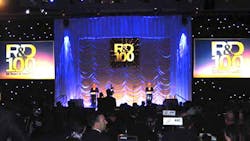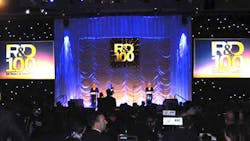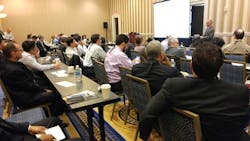The 54th R&D 100 Awards Honor Inventions & Innovations
This file type includes high resolution graphics and schematics when applicable.
The R&D 100 Awards have long been considered the most globally prestigious recognition of inventions and innovations. Companies compete from all over the world, making the event a true melting pot of the best minds and products from every corner of the Earth.
Sponsored by R&D Magazine, the awards have contestants compete in one of five categories for the “R&D 100 Awards” in Analytical/Test, IT/Electrical, Mechanical/Materials, Process/Prototyping, and Software/Services.
There are also three levels of “Special Recognition Awards” in bronze, silver, and gold that recognize novelty, usefulness, and other notable achievements. In 2016, there were 16 such awards. They included winners in Corporate Social Responsibility, Green Tech, Market Disruptor Products, and Market Disruptor Services.
Fifty-two judges from industry, academia, and government whittled down a great number of contestant submissions to 275 finalists for the R&D 100 Awards, and 38 finalists for the 16 Special Recognition Awards. Finalists and winners were published in the December 2016 issue. Rumor has it that additional categories might be in the works as advances in several physical and life science areas—as well as in computing and the IoT—are now well along. Check out the submission criteria for next year’s competition to stay abreast of any updates.
Lastly, there are Scientist of the Year and Innovator of the Year Awards. These were given to Dr. Dharmendra Modha, a cognitive-computing pioneer for his work on brain-inspired cognitive computing at IBM, and Anthony Atala, M.D., for his work on regenerative medicine and 3D bioprinting at Wake Forest University. It was a privilege to be seated at the head table and talk with Dr. Atala, a true thought leader. Wake Forest’s scientists were the first to transplant a laboratory-grown organ into humans back in 1999. Dr. Atala and his team may become the first to create a mass-production method for regenerating organs for patients.
The 2016 Winners As A Whole
Stepping back, and looking across the some 118 awards handed out in 2016, several observations may be of interest to MD readers. For example, Taiwan’s ITRI, MIT’s Lincoln Labs, Oak Ridge and Sandia National Labs, and the Dow companies each earned four or more awards and may be strong sources of future innovations. PPG Industries and the Dow companies were the only corporations to pocket more than two awards. The USA’s National Laboratories and other government labs accounted for more than 30 of the 100 awards.
And, finally, corporate contestants declined in number over the past decade despite this being a relatively inexpensive contest to enter. Just being a finalist gives companies a great ROI for product pricing and brand value. For startups and small-scale, it is a great help in attracting money.
Global R&D Funding Forecast
One cannot recap the R&D 100 Awards without mentioning the annual industry forecast that accompanies it. The Industrial Research Institute, America’s oldest organization of corporations, teams up with R&D Magazine to prepare this forecast. An early preview of the forecast was presented at the conference.
New Annual R&D 100 Conference
A great deal of effort goes into producing the R&D 100 awards competition and the culminating awards dinner. People come from all over in hopes of taking home an “Oscar of Invention & Innovation.” Last year at the 53rd awards, R&D Magazine debuted the 1st Annual Technology Conference held concurrently with the awards dinner, providing a much greater sharing opportunity for the large number of wizards who were all in the same place at the same time. It was a big hit. Still a work in progress, the 2016 R&D 100 Conference was highly educational, and all of the presenters broke new ground in some manner.
This file type includes high resolution graphics and schematics when applicable.
About the Author
Bradford Goldense
Contributing Technical Expert
Bradford L. Goldense is founder and president of Goldense Group, Inc. [GGI] (www.goldensegroupinc.com), a consulting, market research, and education firm focused on business and technology management strategies and practices for product creation, development, and commercialization. He has been an adjunct faculty member of the graduate engineering school at Tufts University's Gordon Institute for 19 years. Goldense is a Certified New Product Development Professional [NPDP], a Certified Manufacturing Engineer [CMfgE], a Certified Computer Professional [CCP], and is Certified In Production & Inventory Management [CPIM]. He holds over 200 registered copyrights and is a recognized subject-matter expert, including appearances on PBS and CNBC. He has consulted to over 250 companies and over 750 manufacturing locations on four continents since founding GGI in 1986. Goldense holds an MBA in Accounting from the Cornell Johnson School and a BSCE from Brown University. For more information, please see Brad's LinkedIn profile or visit GGI's home page.




